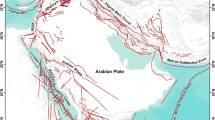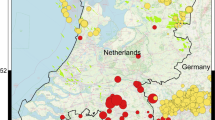Abstract
Arias Intensity (Arias, MIT Press, Cambridge MA, pp 438–483, 1970) is an important measure of the strength of a ground motion, as it is able to simultaneously reflect multiple characteristics of the motion in question. Recently, the effectiveness of Arias Intensity as a predictor of the likelihood of damage to short-period structures has been demonstrated, reinforcing the utility of Arias Intensity for use in both structural and geotechnical applications. In light of this utility, Arias Intensity has begun to be considered as a ground-motion measure suitable for use in probabilistic seismic hazard analysis (PSHA) and earthquake loss estimation. It is therefore timely to develop predictive equations for this ground-motion measure. In this study, a suite of four predictive equations, each using a different functional form, is derived for the prediction of Arias Intensity from crustal earthquakes in New Zealand. The provision of a suite of models is included to allow for epistemic uncertainty to be considered within a PSHA framework. Coefficients are presented for four different horizontal-component definitions for each of the four models. The ground-motion dataset for which the equations are derived include records from New Zealand crustal earthquakes as well as near-field records from worldwide crustal earthquakes. The predictive equations may be used to estimate Arias Intensity for moment magnitudes between 5.1 and 7.5 and for distances (both rjb and rrup) up to 300 km.
Similar content being viewed by others
References
Abercrombie RE (1998) A summary of attenuation measurements from borehole recordings of earthquakes: the 10 Hz transition problem. Pure Appl Geophys 153:475–487
Abercrombie RE, Webb TH, Robinson R, McGinty PJ, Mori JJ, Beavan RJ (2000) The enigma of the Arthur’s Pass, New Zealand, earthquake 1. Reconciling a variety of data for an unusual earthquake sequence. J Geophys Res 105(B7):16119–16137
Abrahamson NA, Silva WJ (1997) Empirical response spectral attenuation relations for shallow crustal earthquakes. Seism Res Lett 68(1):94–127
Akaike H (1974) A new look at the statistical model identification. IEEE Trans Automat Contr 19(6):716–723
Allen TI, Gibson G, Brown A, Cull JP (2004) Depth variation of seismic source scaling relations: implications for earthquake hazard in southeastern Australia. Tectonophysics 390(1–4):5–24
Anderson JG, Hough SE (1984) A model for the shape of the Fourier amplitude spectrum of acceleration at high-frequencies. Bull Seismol Soc Am 74(5):1969–1993
Anderson H, Webb T, Jackson J (1993) Focal mechanisms of large earthquakes in the South-Island of New-Zealand – implications for the accommodation of Pacific-Australia plate motion. Geophys J Int 115(3):1032–1054
Arias A (1970) A measure of earthquake intensity. In: Hansen RJ (ed) Seismic design for nuclear power plants. MIT Press, Cambridge MA, pp 438–483
Arnadottir T, Beavan J, Pearson C (1995) Deformation associated with the 18 June 1994 Arthur’s Pass earthquake, New Zealand. NZ J Geol Geophys 38(4):553–558
Baker JW, Cornell CA (2006) Which spectral acceleration are you using? Earthq Spectra 22(2):293–312
Beyer K, Bommer JJ (2006) Relationships between median values and between aleatory variabilities for different definitions of the horizontal component of motion. Bull Seismol Soc Am 96(4A):1512–1522 [Erratum 97(5):1769]
Bommer JJ, Scherbaum F, Bungum H, Cotton F, Sabetta F, Abrahamson NA (2005) On the use of logic trees for ground-motion prediction equations in seismic-hazard analysis. Bull Seismol Soc Am 95(2):377–389
Bommer JJ, Stafford PJ, Alarcón JE, Akkar S (2007) The influence of magnitude range on empirical ground-motion prediction. Bull Seismol Soc Am 97(6):2152–2170
Boore DM (2003) Simulation of ground motion using the stochastic method. Pure Appl Geophys 160(3–4):635–676
Boore DM (2004) Can site response be predicted? J Eq Eng 8:1–41
Boore DM, Joyner WB (1997) Site amplifications for generic rock sites. Bull Seismol Soc Am 87(2):327–341
Boore DM, Watson-Lamprey J, Abrahamson NA (2006) Orientation-independent measures of ground motion. Bull Seismol Soc Am 96(4):1502–1511
Brune JN (1970) Tectonic stress and spectra of seismic shear waves from earthquakes. J Geophys Res 75(26):4997–5009
Cousins WJ, Zhao JX, Perrin ND (1999) A model for the attenuation of peak ground acceleration in New Zealand earthquakes based on seismograph and accelerograph data. Bull NZ Soc Eq Eng 32(4):193–217
Del Gaudio V, Pierri P, Wasowski J (2003) An approach to time-probabilistic evaluation of seismically induced landslide hazard. Bull Seismol Soc Am 93(2):557–569
Doser DI, Webb TH, Maunder DE (1999) Source parameters of large historical (1918–1962) earthquakes, South Island, New Zealand. Geophys J Int 139(3):769–794
Douglas J (2003) Earthquake ground motion estimation using strong-motion records: a review of equations for the estimation of peak ground acceleration and response spectral ordinates. Earth-Sci Rev 61(1–2):43–104
Dowrick DJ, Rhoades DA (1998) Magnitudes of New Zealand earthquakes, 1901–1993. Bull NZ Soc Eq Eng 31(4):260–280
Dowrick DJ, Rhoades DA (2004) Relations between earthquake magnitude and fault rupture dimensions: how regionally variable are they? Bull Seismol Soc Am 94(3):776–788
Dziewonski AM, Ekstrom G, Salganik MP (1993) Centroid-moment tensor solutions for January March 1992. Phys Earth Plan Int 77(3–4):143–150
Dziewonski AM, Ekstrom G, Salganik MP (1995) Centroid-moment tensor solutions for October December 1994. Phys Earth Plan Int 91(4):187–201
Dziewonski AM, Ekstrom G, Salganik MP (1996) Centroid-moment tensor solutions for January March 1995. Phys Earth Plan Int 93(3–4):147–157
Dziewonski AM, Franzen JE, Woodhouse JH (1985) Centroid-moment tensor solutions for April June, 1984. Phys Earth Plan Int 37(2–3):87–96
Eberhart-Phillips D, McVerry G (2003) Estimating slab earthquake response spectra from a 3D Q model. Bull Seismol Soc Am 93(6):2649–2663
Egan JA, Rosidi D (1991) Assessment of earthquake-induced liquefaction using ground-motion energy characteristics. In: Proceedings of the pacific conference on earthquake engineering. Auckland, New Zealand
Ekstrom G, Dziewonski AM, Maternovskaya NN, Nettles M (2005a) Global seismicity of 2002: centroid-moment-tensor solutions for 1034 earthquakes. Phys Earth Plan Int 148(2–4):303–326
Ekstrom G, Dziewonski AM, Maternovskaya NN, Nettles M (2005b) Global seismicity of 2003: centroid-moment-tensor solutions for 1087 earthquakes. Phys Earth Plan Int 148(2–4):327–351
Gledhill K, Robinson R, Webb T, Abercrombie R, Beavan J, Cousins J (2000) The Mw 6.2 Cass, New Zealand, earthquake of 24 November 1995: reverse faulting in a strike-slip region. NZ J Geol Geophys 43(2):255–269
Hanks TC, Kanamori H (1979) Moment magnitude scale. J Geophys Res 84(NB5):2348–2350
Harp EL, Wilson RC (1995) Shaking intensity thresholds for rock falls and slides: evidence from 1987 Whittier Narrows and Superstition Hills earthquake strong-motion records. Bull Seismol Soc Am 85(6):1739–1757
Hincapie JO, Doser DI, Robinson R (2005) Stress changes induced by earthquakes and secular stress accumulation in the Buller region, South Island, New Zealand (1929–2002). Pure Appl Geophys 162:291–310
Hwang H, Lin CK, Yeh YT, Cheng SN, Chen KC (2004) Attenuation relations of Arias intensity based on the Chi-Chi Taiwan earthquake data. Soil Dyn Eq Eng 24:509–517
Kagawa T, Irikura K, Somerville P (2004) Differences in ground motion and fault rupture process between the surface and buried fault rupture earthquakes. Earth Planets Space 56:3–14
Kayen RE, Mitchell JK (1997) Assessment of liquefaction potential during earthquakes by Arias intensity. J Geotech Geoenviron Eng 123(12):1162–1174
Keefer DK, Wilson RC (1989) Predicting earthquake-induced landslides, with emphasis on arid and semi-arid environments. In: Sadler PM, Morton DM (eds) Landslides in a semi-arid environment, vol 2. Inland Geological Society, pp 118–149
Kramer SL, Mitchell RA (2006) Ground motion intensity measures for liquefaction hazard evaluation. Earthq Spectra 22(2):413–438
Lindstrom MJ, Bates DM (1990) Nonlinear mixed effects models for repeated measures data. Biometrics 46:673–687
Mai PM, Spudich P, Boatwright J (2005) Hypocenter locations in finite-source rupture models. Bull Seismol Soc Am 95(3):965–980
Matcham I, Savage MK, Taber JJ, Reyners M (2006) Earthquake source mechanism analysis for events between 1992 and 1997 using sparse New Zealand broadband data. NZ J Geol Geophys 49(1):75–89
McGinty P (2004) The 2003, Mw 7.2 Fiordland earthquake, and its near-source aftershock strong motion data. Bull NZ Nat Soc Eq Eng 37(3):139–149
McGinty P, Robinson R (1999) Slip distribution of the Lake Tennyson earthquake, New Zealand, as inferred from static stress changes and off fault aftershocks. Geophys Res Lett 26(13):1961–1964
McGinty P, Robinson R, Taber J, Reyners M (1997) The 1990 Lake Tennyson earthquake sequence, Marlborough, New Zealand. NZ J Geol Geophys 40(4):521–535
McGinty P, Robinson R, Webb T (2005) The 2001 M L 6.2 Jackson Bay earthquake sequence, South Island, New Zealand. NZ J Geol Geophys 48(2):315–324
McVerry GH, Zhao JX, Abrahamson NA, Somerville PG (2006) New Zealand acceleration response spectrum attenuation relations for crustal and subduction zone earthquakes. Bull NZ Soc Earthq Eng 39(4):1–58
Olafsson S (1999) Estimation of earthquake-induced response. Dissertation. Department of Structural Engineering, Norwegian University of Science and Technology, Trondheim, Norway, p 140
Olafsson S, Sigbjornsson R (1999) A theoretical attenuation model for earthquake-induced ground motion. J Earthq Eng 3(3):287–315
Peláez J, Delgado J, Casado CL (2005) A preliminary probabilistic seismic hazard assessment in terms of Arias intensity in southeastern Spain. Eng Geol 77:139–151
Reyners M, McGinty P, Cox S, Turnbull I, O’Neill T, Gledhill K, Hancox G, Beavan J, Matheson D, McVerry G, Cousins J, Zhao J, Cowan H, Caldwell G, Bennie S, GeoNet Team (2003) The Mw7.2 Fiordland earthquake of August 21, 2003: background and preliminary results. Bull NZ Nat Soc Earthq Eng 36(4):233–248
Robinson R, McGinty PJ (2000) The enigma of the Arthur’s Pass, New Zealand, earthquake 2. The aftershock distribution and its relation to regional and induced stress fields. J Geophys Res 105(B7):16139–16150
Robinson R, Webb T, McGinty P, Cousins J, Eberhart-Phillips D (2003) The 2000 Thompson Sound earthquake, New Zealand. NZ J Geol Geophys 46(3):331–341
Sabetta F, Pugliese A (1996) Estimation of response spectra and simulation of nonstationary earthquake ground motions. Bull Seismol Soc Am 86(2):337–352
Schwarz G (1978) Estimating the dimension of a model. Ann Stat 6(2):461–464
Somerville P, Pitarka A (2006) Differences in earthquake source and ground motion characteristics between surface and buried faulting earthquakes. In: Proceedings of the 8th U.S. national conference on earthquake engineering. San Francisco, CA
Stafford PJ (2006) Engineering seismological studies and seismic design criteria for the Buller region, South Island, New Zealand. Research report 2006–03. Civil engineering research report. Christchurch, University of Canterbury, p 413
Stafford PJ, Berrill JB, Pettinga JR (2006) New empirical predictive equations for the Fourier amplitude spectrum of acceleration and Arias intensity in New Zealand. In: Proceedings of the first european conference on earthquake engineering and seismology. Geneva, Switzerland
Standards New Zealand (2004) NZS1170.5:2004 structural design actions – earthquake actions. Standards New Zealand, Wellington
Travasarou T, Bray JD, Abrahamson NA (2003) Empirical attenuation relationship for Arias intensity. Earthq Eng Struct Dyn 32(7):1133–1155
Webb TH, Anderson H (1998) Focal mechanisms of large earthquakes in the North Island of New Zealand: slip partitioning at an oblique active margin. Geophys J Int 134(1):40–86
Wilson RC (1993) Relation of Arias intensity to magnitude and distance in California. Open file report 93–556. Reston, Virginia, US Geological Survey, p 42
Wilson RC, Keefer DK (1985) Predicting the areal limits of earthquake-induced landsliding. In: Ziony JI (ed) Evaluating earthquake hazards in the Los Angeles Region – an earth-science perspective. US Geological Survey Professional Paper 1360, Washington DC, pp 316–345
Zhao JX, Dowrick DJ, McVerry GH (1997) Attenuation of peak ground accelerations in New Zealand earthquakes. Bull NZ Nat Soc Earthq Eng 30(2):133–158
Author information
Authors and Affiliations
Corresponding author
Rights and permissions
About this article
Cite this article
Stafford, P.J., Berrill, J.B. & Pettinga, J.R. New predictive equations for Arias intensity from crustal earthquakes in New Zealand. J Seismol 13, 31–52 (2009). https://doi.org/10.1007/s10950-008-9114-2
Received:
Accepted:
Published:
Issue Date:
DOI: https://doi.org/10.1007/s10950-008-9114-2




